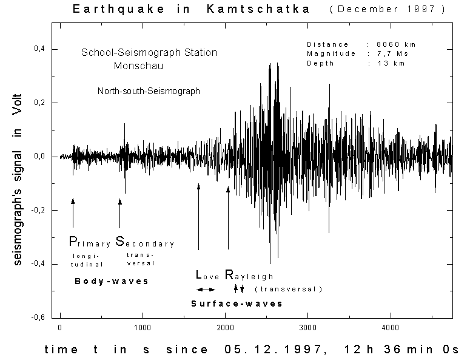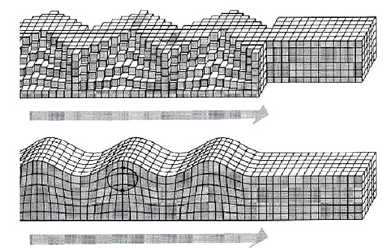2. On the seismogram as a "Journey through the interior of the earth"
A seismogram is fundamentally a report of the journey of earthquake waves through the interior of the earth. Through the exploration of earthquake waves we have ascertained how our earth is made up even in its very depths (compare Fig. 10). Remember: even the deepest continental drills have only reached about 10km below the surface, the radius of the earth being circa 6000km.
Before we become more familiar with the various types of earthquake-waves, here is another aside about epicentres of earthquakes. The actual centre of a quake within the earth is named 'Hypocentre' (marked H in Fig. 10) whereas that place which lies perpendicular to this on the earth's surface is named 'Epicentre', (marked E in Fig. 10).
We distinguish between two types of quake-waves; body waves and surface waves. All wave types are visible within the following graph.
The surface waves expand, as the name indicates, near the earth's surface and so progress from the epicentre E to the station S (compare Fig. 10). They reach the station somewhat later than the faster body waves, which go more directly through the earth from epicentre H to the seismographic station S.
We will remain for the moment with the subject of surface waves, which are transverse waves. One distinguishes between two types of propagation, which are both named after English physicists.
First we receive the faster 'Love Wave' at our station. This wave makes the earth oscillate horizontally. Following on from this we receive the 'Rayleigh Wave' that makes the earth's surface oscillate up and down. The amplitudes of the surface waves rapidly decrease with increasing depth.
As the surface waves are, so to speak 'imprisoned in the earth-crust', they only expand two-dimensionally and lose far less energy than body waves. The surface waves are therefore those that create such disastrous damage in buildings, as well as in water and gas pipes and electricity lines.

